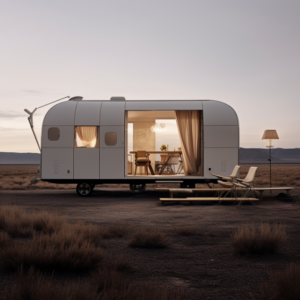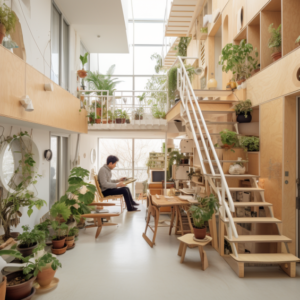Nomadic living, once associated purely with functionality and practicality, has evolved into an art form where architecture plays a central role. This article delves into the aesthetic dimensions of nomadic homes, exploring how designers and architects are merging functionality with artistic expression to create visually stunning, culturally rich, and highly adaptable living spaces. From the unique visual identity of portable dwellings to the cultural influences shaping their design, the art of nomadic homes represents a celebration of form and function.
1. Introduction:
Nomadic living has transcended mere necessity and become a canvas for artistic expression in architecture. This section introduces the aesthetic aspect of nomadic homes, exploring how the marriage of art and functionality is reshaping our perception of these transient living spaces.
2. Visual Identity of Portable Dwellings:
Portable dwellings, by nature, possess a distinctive visual identity. This section delves into the unique architectural features that define nomadic homes, from the sleek lines of tiny houses on wheels to the organic shapes of lightweight tents. Case studies showcase the diverse visual languages employed by architects to create homes that are not only functional but also visually striking.
3. Cultural Influences on Nomadic Design:
Nomadic architecture draws inspiration from a rich tapestry of cultural influences. This section explores how different cultural elements, including traditional patterns, materials, and craftsmanship, shape the aesthetic choices in nomadic design. The fusion of modern and traditional aesthetics creates homes that tell a story about the people who inhabit them.
4. Nomadic Artistry in Modular Habitats:
Modular habitats offer a canvas for nomadic artistry, allowing for customization and personalization. This section showcases how designers leverage modular design principles to create aesthetically pleasing and adaptable living spaces. The integration of art into functional components, such as furniture and interior design, exemplifies the intersection of creativity and practicality.
5. Technology as an Aesthetic Tool:
Technology not only enhances the functionality of nomadic homes but also serves as a tool for artistic expression. This section explores how smart home integration, innovative materials, and cutting-edge construction techniques contribute to the aesthetic appeal of nomadic dwellings. Examples illustrate how technology becomes an integral part of the visual narrative of these homes.
6. Sustainable Aesthetics:
Nomadic living and sustainability often go hand in hand. This section examines how sustainable practices and materials contribute to the aesthetic appeal of nomadic homes. The use of eco-friendly materials, energy-efficient design, and integration with natural surroundings showcase the beauty of environmentally conscious architecture.
7. Art in Motion:
The transient nature of nomadic living adds a dynamic dimension to its aesthetics. This section explores how the movement and adaptability of nomadic homes contribute to their artistic appeal. From the changing landscapes outside to the flexible interiors, nomadic homes become a form of art in motion, constantly evolving with their surroundings.
8. Challenges and Innovations in Nomadic Aesthetics:
Creating aesthetically pleasing nomadic homes comes with its set of challenges. This section addresses the obstacles designers face, such as space constraints and mobility considerations, and explores innovative solutions that push the boundaries of nomadic aesthetics.
9. Case Studies in Nomadic Artistry:
A series of case studies delve into exemplary nomadic architecture projects, highlighting the artistic choices, cultural influences, and innovative solutions that define their visual appeal. Each case study provides insights into the creative processes of architects and the resulting impact on the overall aesthetic experience of nomadic living.
10. Future Trends in Nomadic Aesthetics:
As the art of nomadic homes continues to evolve, this section speculates on future trends and emerging aesthetics in nomadic architecture. From the influence of art movements to advancements in virtual and augmented reality, the article explores potential directions for the visual language of nomadic living.
11. Conclusion:
Nomadic homes are not just structures; they are expressions of art in motion. As architects and designers push the boundaries of creativity, nomadic living becomes a celebration of form, function, and cultural richness. The art of nomadic homes invites us to appreciate the beauty in transience and challenges conventional notions of what a home can be, reminding us that in the realm of nomadic architecture, aesthetics are as important as functionality.



